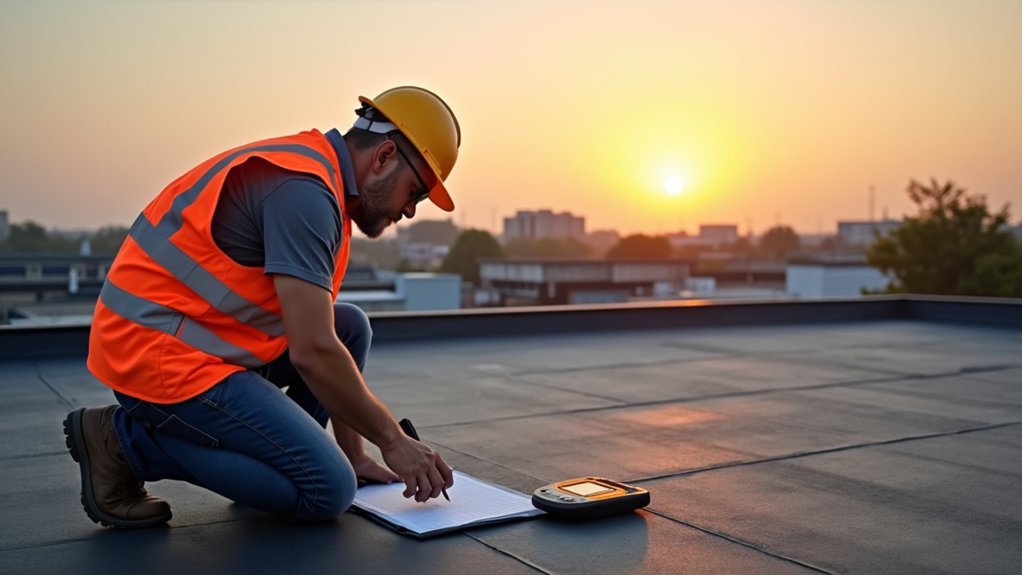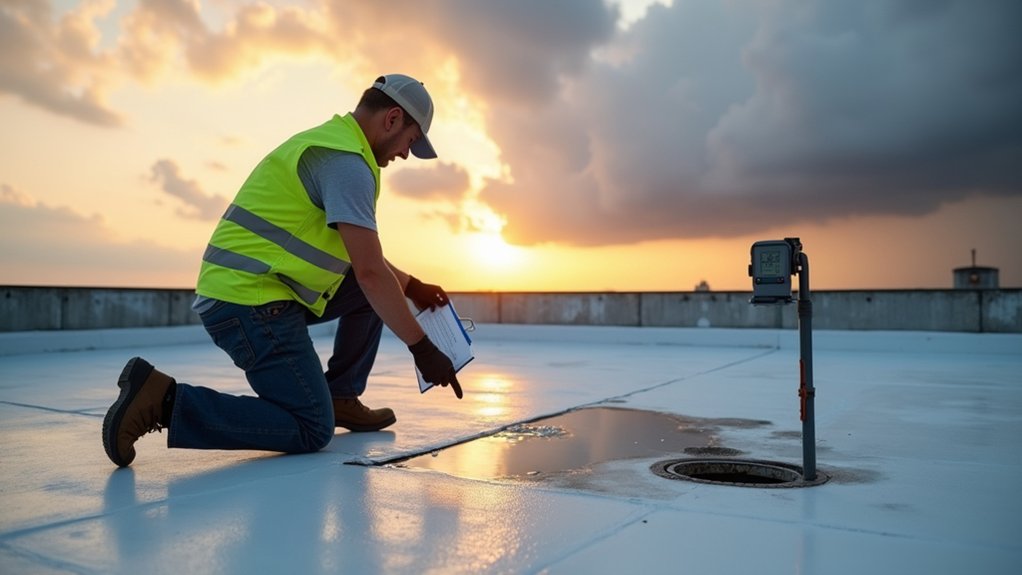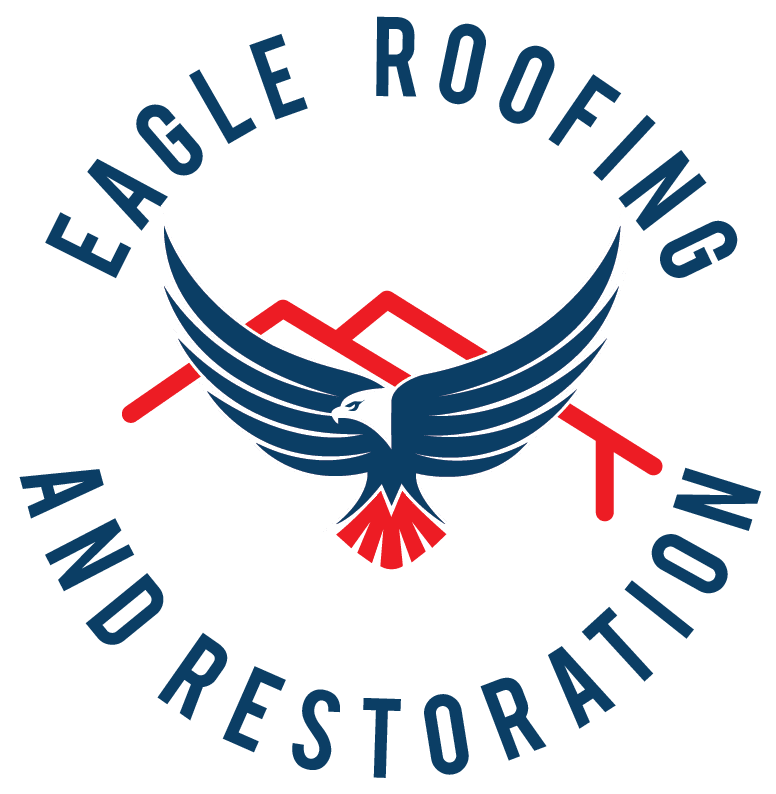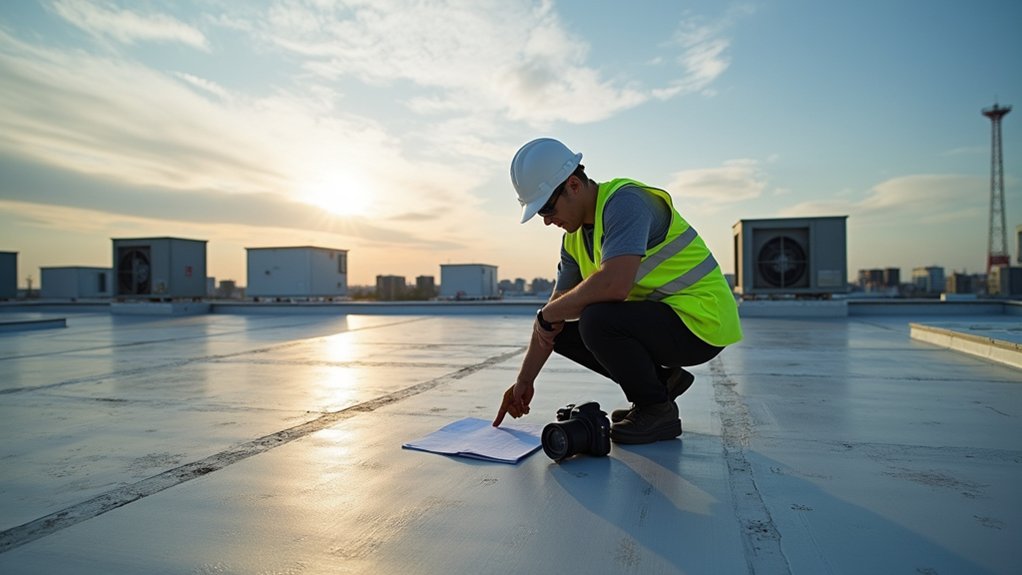Commercial roofs require bi-annual professional inspections at minimum, with specific frequencies varying by material type. You’ll need to schedule built-up and modified bitumen roofs twice yearly, single-ply systems three times annually, and metal roofs once per year plus post-storm checks. Additional inspections become necessary for roofs over ten years old or those exposed to harsh conditions. Your maintenance strategy should also include monthly visual checks by in-house staff there’s much more to ponder when developing an all-encompassing inspection plan.
Recommended Inspection Frequencies for Different Roof Types

Different roofing systems require varying inspection frequencies to maintain their integrity and extend their service life. You’ll need to schedule inspections based on specific roof material characteristics and local climate conditions.
For built-up and modified bitumen roofs, plan bi-annual inspections in spring and fall. Single-ply membrane systems (EPDM, TPO, PVC) should undergo professional assessment three times yearly to monitor seam integrity and surface wear. Metal roofs typically need inspection once annually, but you’ll want to check them after severe storms for potential impact damage.
Watch for key roof condition indicators like ponding water, membrane blistering, or loose fasteners. You should increase inspection frequency for roofs over ten years old or those exposed to harsh environmental conditions, chemical emissions, or heavy foot traffic.
Critical Signs That Warrant Immediate Roof Inspection
While regular inspection schedules help prevent major roofing issues, certain warning signs demand your immediate attention regardless of the routine maintenance calendar. Don’t wait for scheduled maintenance if you notice water stains on interior ceilings, bubbling or peeling paint, or musty odors these water damage indicators suggest active leaks that require urgent assessment.
Schedule an immediate inspection when you observe structural integrity concerns such as sagging roof sections, excessive deflection, or visible deck deterioration. You’ll also need prompt professional evaluation if you spot membrane blistering, separated seams, loose flashings, or damaged drainage components. After severe weather events like hailstorms, high winds, or heavy snow accumulation, it’s essential to check for impact damage, torn materials, and compromised attachment points that could lead to system failure.
Seasonal Inspection Requirements and Weather Considerations

Seasonal changes directly impact commercial roofing systems, requiring specific inspection protocols throughout the year. You’ll need to schedule thorough inspections during spring and fall to assess winter damage and prepare for severe weather conditions.
During winter months, prioritize snow load monitoring to prevent structural stress and potential collapse. You should inspect drainage systems before winter to guarantee proper snowmelt management. In preparation for summer, examine roof membranes for UV damage and thermal stress.
Storm preparation becomes critical during severe weather seasons. You must evaluate roof attachments, flashings, and membrane conditions before hurricane or tornado seasons. Check weather stripping, seal integrity, and drainage capacity to avert water infiltration. Document all seasonal inspections to maintain warranty compliance and establish maintenance patterns that reflect your region’s specific climate challenges.
Professional vs. In-House Inspection Guidelines
Licensed roofing contractors bring specialized equipment, certification-based knowledge, and deep experience in complex commercial systems that you won’t find with typical maintenance staff. Your in-house team can effectively handle routine visual inspections, basic debris removal, and early problem detection during their regular maintenance rounds. While professional contractors should manage thorough structural assessments and technical evaluations, your maintenance personnel serve as the first line of defense in identifying potential issues that require expert attention.
Contractor Expertise and Capabilities
Determining whether to hire professional contractors or rely on in-house staff for commercial roof inspections requires careful evaluation of expertise levels and inspection capabilities. You’ll need to assess your team’s technical knowledge against the specialized skills that certified roofing contractors possess.
During the contractor selection process, verify their credentials, insurance coverage, and track record with similar commercial properties. Professional contractors bring advanced diagnostic tools, safety equipment, and thorough reporting systems that most in-house teams can’t match. They’re also familiar with local building codes and warranty requirements.
Establish clear contractor communication strategies before starting inspections. You’ll want detailed documentation of findings, recommended repairs, and maintenance schedules. Professional contractors should provide digital reports, photos, and prioritized action items that help you make informed decisions about your roof’s maintenance needs.
Internal Maintenance Team Duties
Your internal maintenance team should focus on routine visual inspections and basic preventive tasks while leaving complex diagnostic work to professional contractors. As part of your asset management strategy, train your team to conduct monthly walk-throughs and document their findings systematically.
| In-House Tasks | Professional Tasks |
|---|---|
| Visual inspections | Detailed assessments |
| Basic debris removal | Core sampling |
| Documentation procedures | Thermal imaging |
Your maintenance staff should maintain detailed logs of their observations, including photos of potential issues and dates of inspections. They’ll need to monitor drainage systems, clear debris from gutters, and check for obvious signs of wear. When they spot concerning conditions like standing water, blistering, or membrane separation, they should promptly notify your roofing contractor for expert evaluation.
Cost-Benefit Analysis of Regular Roof Inspections

While regular commercial roof inspections require an upfront investment, they consistently prove to be one of the most cost-effective maintenance decisions you can make. Through proactive risk management, you’ll identify and address minor issues before they escalate into major repairs, potentially saving thousands in emergency restoration costs.
Consider that a thorough inspection program typically costs 10-20 cents per square foot annually, while emergency repairs can exceed $15 per square foot. You’ll also benefit from extended roof lifespan, reduced energy costs through early detection of insulation issues, and maintained warranty coverage. Cost effective roof maintenance helps you avoid business disruptions, protect valuable inventory, and prevent structural damage. When you factor in these benefits against inspection costs, the return on investment becomes clear and measurable.
Essential Components of a Commercial Roof Inspection
A thorough commercial roof inspection encompasses several critical elements that work together to provide a complete assessment of your roofing system’s condition. Your inspector will evaluate the roof membrane condition, checking for tears, blisters, punctures, and signs of deterioration. They’ll also perform a comprehensive roof drainage assessment to guarantee water flows properly through gutters, downspouts, and internal drains.
The inspection includes examining flashings around penetrations, HVAC units, and roof edges, as well as evaluating seams and joints for potential water entry points. Your inspector will also assess the structural integrity of supporting elements, document any signs of past leaks or repairs, and review the condition of expansion joints. They’ll check for proper ventilation and inspect the underlayment and insulation where visible or accessible.
Compliance and Insurance Requirements for Roof Maintenance
Regular roof inspections not only maintain your building’s structural integrity but also satisfy indispensable compliance and insurance requirements. You’ll need to familiarize yourself with local building codes, OSHA regulations, and specific insurance policy details that govern your commercial property’s roof maintenance schedule.
Most insurance providers require documented proof of regular inspections and maintenance to maintain coverage validity. You’ll find that compliance requirements often mandate bi-annual or quarterly inspections, depending on your building’s size, age, and local climate conditions. Failure to meet these requirements can result in denied claims, policy cancellations, or increased premiums.
Keep detailed records of all inspections, repairs, and maintenance activities to demonstrate your adherence to both regulatory standards and insurance specifications. These documents serve as essential evidence during insurance audits or compliance reviews.
Frequently Asked Questions
Can Roof Inspections Be Performed While Tenants Occupy the Building?
Yes, you can conduct roof inspections during tenancy, as most commercial roof evaluations don’t substantially impact tenant operations. You’ll find that experienced inspectors typically work efficiently to minimize tenant disruption, often completing their assessment without occupants even noticing. They’ll coordinate access through service entrances and utilize methods that reduce noise and interference. For sensitive operations, you can schedule inspections during off-peak hours or weekends.
What Qualifications Should I Look for When Hiring a Roof Inspection Company?
You’ll want to work with licensed roofers and certified inspectors who have specific commercial roofing experience. Look for companies that hold industry certifications from organizations like NRCA (National Roofing Contractors Association) or IIBEC (International Institute of Building Enclosure Consultants). Ask for proof of liability insurance and worker’s compensation coverage. Don’t forget to check their track record through references, reviews, and their portfolio of completed commercial inspections.
How Long Does a Typical Commercial Roof Inspection Take to Complete?
You’ll find that inspection duration varies based on your building’s size and complexity. A typical commercial roof inspection takes 2-4 hours for properties up to 20,000 square feet. Larger facilities may require a full day or more. When inspection scheduling, you’ll want to factor in time for detailed assessment of drainage systems, penetrations, and flashing points. Your inspector will also need time to document findings and prepare a thorough report.
Are Drone Inspections as Effective as Traditional Commercial Roof Inspections?
While drone inspections can provide valuable aerial perspectives, they’re not yet a complete replacement for traditional hands-on inspections. You’ll find that drone footage quality has improved greatly, but it can’t detect subtle issues like membrane adhesion or minor leaks. Additionally, inspector training protocols for traditional inspections are more extensive and standardized. For best results, you should use drone technology as a complementary tool alongside physical inspections rather than a standalone solution.
Should I Get a Second Opinion if Major Roof Repairs Are Recommended?
Yes, you should definitely seek alternate inspection when major roof repairs are recommended. It’s a considerable investment, and getting a second professional opinion helps validate the initial assessment and guarantees you’re making informed decisions. You’ll want to obtain multiple quotes from reputable contractors, as pricing and repair approaches can vary drastically. This practice not only safeguards your investment but also helps you understand the full scope of necessary repairs.

